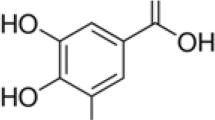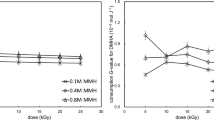Abstract
The radiolytic behaviors of aqueous ammonia solutions under γ-ray irradiation were investigated, focusing on several factors, including initial ammonia concentration, absorbed dose, and H3BO3 concentration. The main species including ammonia, H2O2, nitrogen oxides, and H2, were quantitatively analyzed. The results revealed the significant influence of the initial ammonia concentration on the radiolytic behavior of the aqueous ammonia solution. The existence of ammonia in the solution exhibited suppression of the concentrations of H2O2 and O2. Furthermore, the radiolysis of aerated aqueous ammonia solution led to the formation of nitrogen oxides (NO2− and NO3−). This process was driven by multiple oxidation reactions, in which O2 and ·OH played crucial roles. Interestingly, the addition of H3BO3 provided protection to ammonia during γ irradiation, while the concentration of H2O2 was increased.










Similar content being viewed by others
References
Kysela J, Zmítko M, Yurmanov VA, Tiapkov VF (1996) Primary coolant chemistry in VVER units. Nucl Eng Des 160(1):185–192. https://doi.org/10.1016/0029-5493(95)01096-3
Dey GR (2011) Nitrogen compounds’ formation in aqueous solutions under high ionizing radiation: an overview. Radiat Phys Chem 80(3):394–402. https://doi.org/10.1016/j.radphyschem.2010.10.010
Bulanov A, Kolesov B, Lukashenko M, Khudyakov A, Kabakchi S, Arkhipov O (2000) Radiolysis of ammonia in the first-loop coolant of reactors in floating power-generating units. At Energ 88(5):368. https://doi.org/10.1007/BF02680531
Uchida S, Katsumura Y (2013) Water chemistry technology–one of the key technologies for safe and reliable nuclear power plant operation. J Nucl Sci Technol 50(4):346–362. https://doi.org/10.1080/00223131.2013.773171
Fang Z, Cao X, Tong L, Muroya Y, Whitaker G, Momeni M, Lin M (2018) An improved method for modeling coolant radiolysis in ITER. Fusion Eng Des 127:91–98. https://doi.org/10.1016/j.fusengdes.2017.12.031
Bartels DM, Henshaw J, Sims HE (2013) Modeling the critical hydrogen concentration in the AECL test reactor. Radiat Phys Chem 82:16–24. https://doi.org/10.1016/j.radphyschem.2012.09.012
Elliot AJ, Bartels DM (2009) The reaction set, rate constants, and g-values for the simulation of the radiolysis of light water over the range 20˚C to 350˚C based on information available in 2008. Atomic Energy of Canada Limited., No. AECL--153–127160–450–001.
Andresen PL, Was GS (2019) A historical perspective on understanding IASCC. J Nucl Mater 517:380–392. https://doi.org/10.1016/j.jnucmat.2019.01.057
Raiman SS, Bartels DM, Was GS (2017) Radiolysis driven changes to oxide stability during irradiation-corrosion of 316L stainless steel in high temperature water. J Nucl Mater 493:40–52. https://doi.org/10.1016/j.jnucmat.2017.05.042
Fang Z, Tang J, Xiao J, Tong L, Cao X, Weng H, Lin M (2019) Modelling electrical corrosion potential of 304 stainless steel under fusion power plant environment. J Radioanal Nucl Ch 319:303–314. https://doi.org/10.1007/s10967-018-6299-x
Pastina B, Isabey J, Hickel B (1999) The influence of water chemistry on the radiolysis of the primary coolant water in pressurized water reactors. J Nucl Mater 264(3):309–318. https://doi.org/10.1016/S0022-3115(98)00494-2
LeSurf L, Bryant P, Tanner M (1967) Use of Ammonia to suppress oxygen production and corrosion in boiling-water reactors. Corrosion 23(3):57–64. https://doi.org/10.5006/0010-9312-23.3.57
Dwibedy P, Kishore K, Dey G, Moorthy P (1995) Radiolysis of ammonia-water systems. In: Proceedings of the symposium on current trends in water chemistry of nuclear and thermal power plants and other related units, India
Men’kin V, Makarov I, Pikaev A (1989) Pulse radiolysis study of reaction rates of OH and O− radicals with ammonia in aqueous solutions. High Energy Chem 22(5):333–336
Grachev VA, Sazonov AB (2021) Radiolysis of aqueous ammonia solutions: mathematical modeling. High Energy Chem 55(6):472–481. https://doi.org/10.1134/S0018143921060072
Brunning J, Cake P, Harper A, Sims H (1997) Some observations on hydrazine and ammonia based chemistries in PWRs. AEA Technology, Oxon, No. IAEA-TECDOC-927
Buxton GV, Lynch DA (1998) Investigation of the NH2 radical in aqueous solution up to 200°C by pulse radiolysis. J Chem Soc, Faraday Trans 94(21):3271–3274. https://doi.org/10.1039/A805892J
Dwibedy P, Kishore K, Dey GR, Moorthy PN (1996) Nitrite formation in the radiolysis of aerated aqueous solutions of ammonia. Radiat Phys Chem 48(6):743–747. https://doi.org/10.1016/S0969-806X(96)00037-0
Nagy G, Tilky P, Horváth Á, Pintér T, Schiller R (2001) Kinetic and statistical analysis of primary circuit water chemistry data in a VVER power plant. Nucl Technol 136(3):331–341. https://doi.org/10.13182/NT01-A3249
Huang L, Li L, Dong W, Liu Y, Hou H (2008) Removal of ammonia by OH radical in aqueous phase. Environ Sci Technol 42(21):8070–8075. https://doi.org/10.1021/es8008216
Neta P, Maruthamuthu P, Carton P, Fessenden R (1978) Formation and reactivity of the amino radical. J Phys Chem 82(17):1875–1878. https://doi.org/10.1021/j100506a004
Hickel B, Sehested K (1992) Reaction of hydroxyl radicals with ammonia in liquid water at elevated temperatures. Int J Radiation Appl Instrum Part C Radiat Phys Chem 39(4):355–357. https://doi.org/10.1016/1359-0197(92)90244-A
Buxton GV, Stuart CR (1996) Radiation chemistry of aqueous solutions of hydrazine at elevated temperatures Part 1—Oxygen-free solutions. J Chem Soc, Faraday Trans 92(9):1519–1525. https://doi.org/10.1039/FT9969201519
Buxton GV, Stuart CR (1997) Radiation chemistry of aqueous solutions of hydrazine at elevated temperatures Part 2—Solutions containing oxygen. J Chem Soc, Faraday Trans 93(8):1535–1538. https://doi.org/10.1039/A608040E
Ibe E, Karasawa H, Nagase M, Utamura M, Uchida S (1989) Behavior of nitrogen compounds in radiation field and nuclear reactor systems. J Nucl Sci Technol 26(8):760–769. https://doi.org/10.1080/18811248.1989.9734380
Steinberg M (1960) Irradiation of NH3-H2O solutions for formation of hydrazine. Brookhaven National Laboratory, New York, No. BNL-613(T-183)
Sakumoto A (1966) Hydrazine formation in the γ-radiolysis of an aqueous solution of ammonia. Bull Chem Soc Jpn 39(6):1349–1349
Rigg T, Scholes G, Weiss J (1952) Chemical actions of ionising radiations in solutions. Part X. The action of X-rays on ammonia in aqueous solution. J Chem Soc :3034–3038. doi: https://doi.org/10.1039/JR9520003034
Luzakov A, Bulanov A, Verkhovskaya A, Kolesov B, Shovikov G, Kabakchi S (2008) Radiation-chemical removal of corrosion hydrogen from VVER first-loop coolant. At Energ 105:402–407. https://doi.org/10.1007/s10512-009-9115-4
Sunaryo GR, Katsumura Y, Ishigure K (1995) Radiolysis of water at elevated temperatures—III Simulation of radiolytic products at 25 and 250°C under the irradiation with γ-rays and fast neutrons. Radiat Phys Chem 45(5):703–714. https://doi.org/10.1016/0969-806X(94)00084-W
Pálfi T, Wojnárovits L, Takács E (2010) Calculated and measured transient product yields in pulse radiolysis of aqueous solutions: Concentration dependence. Radiat Phys Chem 79(11):1154–1158. https://doi.org/10.1016/j.radphyschem.2010.06.004
Buxton GV, Greenstock CL, Helman WP, Ross AB (1988) Critical review of rate constants for reactions of hydrated electrons, hydrogen atoms and hydroxyl radicals (⋅OH/⋅O− in Aqueous Solution. J Phys Chem Ref Data 17(2):513–886. https://doi.org/10.1063/1.555805
Pimblott SM, LaVerne JA (1997) Stochastic simulation of the electron radiolysis of water and aqueous solutions. J Phys Chem A 101(33):5828–5838. https://doi.org/10.1021/jp970637d
Christensen H (2006) Fundamental aspects of water coolant radiolysis. Swedish Nuclear Power Inspectorate, Stockholm, No.SKI-R--06–16
Delcourt M, Belloni J, Saito E (1976) Spectrophotometric studies of the radiolysis of liquid ammonia. J Phys Chem 80(10):1101–1105. https://doi.org/10.1021/j100551a015
Belloni J, Billiau F, Cordier P, Delaire J, Delcourt M (1978) Primary processes studied by pulse radiolysis of liquid ammonia 1 Oxidizing radical scavenging and identification of ultraviolet transient absorption spectrum. J Phys Chem 82(5):532–536. https://doi.org/10.1021/j100494a007
Perkey LM (1975) Absorption spectrum, yield, and decay kinetics of the solvated electron in pulse radiolysis of liquid ammonia at various temperatures. J Phys Chem 79(16):1651–1654. https://doi.org/10.1021/j100583a008
Gordon S, Mulac W, Nangia P (1971) Pulse radiolysis of ammonia gas II Rate of disappearance of the NH2 (X2B1) radical. J Phys Chem 75(14):2087–2093. https://doi.org/10.1021/j100683a004
Pagsberg PB, Eriksen J, Christensen H (1979) Pulse radiolysis of gaseous ammonia-oxygen mixtures. J Phys Chem 83(5):582–590. https://doi.org/10.1021/j100468a006
Willis C, Boyd A, Miller O (1969) Primary yields and mechanism in the radiolysis of gaseous ammonia. Can J Chem 47(16):3007–3016. https://doi.org/10.1139/v69-499
Ghormley J, Stewart A (1956) Effects of γ-radiation on ice. J Am Chem Soc 78(13):2934–2939. https://doi.org/10.1021/ja01594a004
Diesen V, Jonsson M (2014) Formation of H2O2 in TiO2 photocatalysis of oxygenated and deoxygenated aqueous systems: a probe for photocatalytically produced hydroxyl radicals. J Phys Chem C 118(19):10083–10087. https://doi.org/10.1021/jp500315u
Barreiro Fidalgo A, Dahlgren B, Brinck T, Jonsson M (2016) Surface reactions of H2O2, H2, and O2 in aqueous systems containing ZrO2. J Phys Chem C 120(3):1609–1614. https://doi.org/10.1021/acs.jpcc.5b10491
Horne GP (2016) An experimental and computational investigation into the radiolysis of PUREX solvent systems. The University of Manchester, United Kingdom
Shinn MB (1941) Colorimetric method for determination of nitrate. Ind Eng Chem Anal Ed 13(1):33–35. https://doi.org/10.1021/i560089a010
Cai Z, Li X, Katsumura Y, Urabe O (2001) Radiolysis of bicarbonate and carbonate aqueous solutions: product analysis and simulation of radiolytic processes. Nucl Technol 136(2):231–240. https://doi.org/10.13182/NT01-A3241
Peeters Z, Hudson R, Moore M, Lewis A (2010) The formation and stability of carbonic acid on outer Solar system bodies. Icarus 210(1):480–487. https://doi.org/10.1016/j.icarus.2010.06.002
Roth O, LaVerne JA (2011) Effect of pH on H2O2 production in the radiolysis of water. J Phys Chem A 115(5):700–708. https://doi.org/10.1021/jp1099927
Hiroki A, Pimblott SM, LaVerne JA (2002) Hydrogen peroxide production in the radiolysis of water with high radical scavenger concentrations. J Phys Chem A 106(40):9352–9358. https://doi.org/10.1021/jp0207578
Etoh Y, Karasawa H, Ibe E, Sakagami M, Yasuda T (1987) Radiolysis of N2–H2O systems. J Nucl Sci Technol 24(8):672–674. https://doi.org/10.1080/18811248.1987.9735864
Ivanov A, Kovalishin A, Kalashnikova P, Taran M (2022) Decomposition of hydrogen solution in the neighborhood of the coolant saturation temperature as a possible cause of increased oxidation of VVER fuel element. Ann Nucl Energy 178:109380
Yakabuskie PA, Joseph JM, Stuart CR, Wren JC (2011) Long-term γ-radiolysis kinetics of NO3− and NO2− solutions. J Phys Chem A 115(17):4270–4278. https://doi.org/10.1021/jp200262c
Slegers C (2006) A concise introduction on radiation chemistry. Chimie nouvelle
Bratsch SG (1989) Standard electrode potentials and temperature coefficients in water at 298.15 K. J Phys Chem Ref Data 18(1):1–21. https://doi.org/10.1063/1.555839
Vione D, Maurino V, Minero C, Borghesi D, Lucchiari M, Pelizzetti E (2003) New processes in the environmental chemistry of nitrite 2 The role of hydrogen peroxide. Environ Sci Technol 37(20):4635–4641. https://doi.org/10.1021/es0300259
Park JY, Lee YN (1988) Solubility and decomposition kinetics of nitrous acid in aqueous solution. J Phys Chem 92(22):6294–6302. https://doi.org/10.1021/j100333a025
Pagsberg PB (1972) Investigation of the NH2 radical produced by pulse radiolysis of ammonia in aqueous solution. Aspects of Res at Risø 5:209
Buxton G, Sellers R (1987) Reactivity of the hydrated electron and the hydroxyl radical with boric acid in aqueous solutions. Radiat Phys Chem 29(2):137–140. https://doi.org/10.1016/1359-0197(87)90048-8
Garbett K (2002) Review of VVER primary water chemistry and the potential for its use in PWRs: Potassium hydroxide and/or ammonia based water chemistries, EPRI, Palo Alto, CA: No.1003382.
Acknowledgements
This work was supported by the Ye Qi-sun Science Foundation of the National Natural Science Foundation of China (U2241289). We appreciate Mei Sun, Wanting Liu, and Shangfei Wang from the University of Science and Technology of China for their support for the experiments.
Author information
Authors and Affiliations
Corresponding author
Ethics declarations
Conflict of interest
The authors declare that there are no potential competing interests about the work in this paper.
Additional information
Publisher's Note
Springer Nature remains neutral with regard to jurisdictional claims in published maps and institutional affiliations.
Supplementary Information
Below is the link to the electronic supplementary material.
Rights and permissions
Springer Nature or its licensor (e.g. a society or other partner) holds exclusive rights to this article under a publishing agreement with the author(s) or other rightsholder(s); author self-archiving of the accepted manuscript version of this article is solely governed by the terms of such publishing agreement and applicable law.
About this article
Cite this article
Guo, Z., Zhang, Y., Jiao, L. et al. Radiolysis of aerated aqueous ammonia solutions. J Radioanal Nucl Chem 332, 5059–5070 (2023). https://doi.org/10.1007/s10967-023-09239-y
Received:
Accepted:
Published:
Issue Date:
DOI: https://doi.org/10.1007/s10967-023-09239-y




